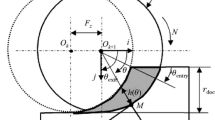Abstract
In machining processes, a decreasing undeformed chip thickness leads to an increase in the specific machining forces. This effect is commonly known as the scaling effect in chip formation. In the literature, several reasons for this effect are discussed. One approach focuses on the increase in the strain rate due to a decrease in the undeformed chip thickness. The increase in the strain rate leads to a hardening effect of the machined material which results in higher specific cutting forces. However, it has not been definitely proven that this is the cause of the scaling effect in chip formation. This paper describes an approach for examining the influence of the strain rate on the scaling effect. Firstly, FE-simulations have been carried out to gain knowledge about the strain rates in the center of the shear zone. By means of these simulations, cutting speeds which lead to constant strain rates in the center of the shear zone have been determined for a broad range of chip thickness. In a second step, experimental investigations have been carried out using the simulated cutting speeds and chip thicknesses. The chip formation processes and the machining forces have been analyzed with constant strain rates and different chip thicknesses as well as with a constant cutting speed. The main result of these investigations is that the strain rate has only a minor influence on the specific cutting forces. It is shown that the temperature in the shear zone decreases with a decrease in the chip thickness. This leads to lower thermal softening of the material and thus to higher specific cutting forces.










Similar content being viewed by others
References
Byrne G, Dornfeld D, Denkena B (2003) Advanced cutting technology. CIRP Ann—Manuf Technol 52(2):483–507
Vollertsen F (2009) Größeneffekte—eine systematische Einordnung. In: Vollertsen F (ed) Größeneinflüsse bei Fertigungsprozessen. Beiträge zum Abschusskolloquium des SPP 1138, Bonn. BIAS-Verlag, Bremen, pp 1–10
Vollertsen F (2008) Categories of size effects. Prod Eng—Res Dev 2(4):377–383
Shaw MC (2003) The size effect in metal cutting. Sadhana 28(5):875–896
Baker WR, Marshall ER, Shaw MC (1952) The size effect in metal cutting. Trans ASME 74:61–72
Dinesh D, Swaminathan S, Chandrasekar S, Farris TN (2001) An intrinsic size-effect in machining due to the strain gradient. In: Proceedings ASME-IMECE, pp 1–8
Larsen-Basse J, Oxley PLB (1973) Effect of strain-rate sensitivity on scale-phenomena in chip formation. In: Proceedings of the 13th international machine tool design and research conference, University of Birmingham, pp 209–216
Stevenson MG, Oxley PLB (1969) An experimental investigation of the influence of speed and scale on the strain-rate in a zone of intense plastic deformation. Proc Inst Mech Eng 184:561–576
Hastings WF, Oxley PLB (1976) Minimum work as a possible criterion for determining the frictional conditions at the tool/chip interface in machining. Phil Trans R Soc London 282:565–584
Herzig N (2008) Erfassung und Beschreibung des skalierten Fließ-, Verfestigungs- und Versagensverhaltens ausgewählter metallischer Werkstoffe. Dr.-Ing. Dissertation, Technische Universität Chemnitz, ISSN 1860-4773
Armarego EJA, Brown RH (1969) The machining of metals. Englewood Cliffs, Prentice-Hall
Kotschenreuther J (2008) Empirische Erweiterung von Modellen der Makrozerspanung auf den Bereich der Mikrozerspanung. Dr.-Ing. Dissertation, Universität Karlsruhe, ISBN 978-3832270414
Kahnis P (2008) Analyse von Größeneinflüssen bei einer Herabskalierung des Fräsprozesses in den Mikrobereich. Dr.-Ing. Dissertation, Technische Universität Dortmund, ISBN 978-3-8027-8745-4
Biermann D, Kahnis P (2010) Analysis and simulation of size effects in micromilling. Prod Eng Res Dev 4(1):25–34
Jivishov V (2008) Mikrogeometrische Einflüsse beim Weich- und Hartspanen. Dr.-Ing. Dissertation, Leibniz Universität Hannover, ISBN 978-3939026914
Klocke F, Gerschwiler K, Abouridouane M (2009) Größeneffekte beim Bohren mit Wendelbohrern in Stahl. In: Vollertsen F (ed) Größeneinflüsse bei Fertigungsprozessen. Beiträge zum Abschusskolloquium des SPP 1138, Bonn. BIAS-Verlag, Bremen, pp 529–548
Siems S, Warnecke G, Aurich JC (2005) Mechanismen der Werkstoffbeanspruchung sowie deren Beeinflussung bei der Zerspanung mit hohen Geschwindigkeiten. In: Tönshoff HK, Hollmann F (eds) Hochgeschwindigkeitsspanen metallischer Werkstoffe. Wiley-VCH Verlag GmbH & Co, KGaA, Weinheim
Johnson GR, Cook WH (1983) A constitutive model and data for metals subjected to large strain, high strain rates and high temperatures. In: 7th international symposium on ballistics, pp 541–547
Kalisch K (2007) FEM-Beschreibung der Einflüsse der Werkzeuggeometrie bei der Hochgeschwindigkeitszerspanung. Dr.-Ing. dissertation, Universität der Bundeswehr Hamburg, ISBN 978-3832258320
Clos R, Radoch S, Schreppel U, Veit P (2009) Größeneffekt und Werkstoffverhalten beim Hartzerspanen von 100Cr6. In: Vollertsen F (ed) Größeneinflüsse bei Fertigungsprozessen. Beiträge zum Abschusskolloquium des SPP 1138, Bonn. BIAS-Verlag, Bremen, pp 347–368
Denkena B, Tönshoff HK (2004) Spanen–Grundlagen. 2 Auflage. Springer, Berlin
Acknowledgments
The authors thank the German Research Foundation (DFG) for funding this work within the project “Influence of the chip cross section shape on the chip formation mechanism” as part of the special research program SPP 1138 “Process Scaling”.
Author information
Authors and Affiliations
Corresponding author
Rights and permissions
About this article
Cite this article
Denkena, B., de Leon, L. & Köhler, J. Influence of scaled undeformed sections of cut on strain rate, cutting force and temperature. Prod. Eng. Res. Devel. 4, 457–464 (2010). https://doi.org/10.1007/s11740-010-0230-9
Received:
Accepted:
Published:
Issue Date:
DOI: https://doi.org/10.1007/s11740-010-0230-9



